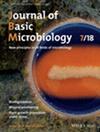Cover: Journal of Basic Microbiology. 3/2025
IF 3.5
4区 生物学
Q2 MICROBIOLOGY
引用次数: 0
Abstract
Cover illustration:
Free-living amoebae of the genus Acanthamoeba produce new antibacterial agents to fight pathogenic bacteria. The antibacterial effect of cell-free supernatants obtained from the depicted Acanthamoeba against some pathogenic bacteria were tested against the control strain Acanthamoeba castellanii ATCC 50373.
(Photo: Şevval Maral Özcan Aykol, Department of Pharmaceutical Microbiology, Biruni University Faculty of Pharmacy, Istanbul, Turkey)

封面:Journal of Basic Microbiology. 3/2025
封面插图:棘阿米巴属的自由生活阿米巴产生新的抗菌剂来对抗致病菌。以对照菌株Acanthamoeba castellanii ATCC 50373为对照,对所制备的棘阿米巴无细胞上清液进行了抑菌试验。(图片来源:Şevval Maral Özcan Aykol,土耳其伊斯坦布尔比uni大学药学院药物微生物学系)
本文章由计算机程序翻译,如有差异,请以英文原文为准。
求助全文
约1分钟内获得全文
求助全文
来源期刊

Journal of Basic Microbiology
生物-微生物学
CiteScore
6.10
自引率
0.00%
发文量
134
审稿时长
1.8 months
期刊介绍:
The Journal of Basic Microbiology (JBM) publishes primary research papers on both procaryotic and eucaryotic microorganisms, including bacteria, archaea, fungi, algae, protozoans, phages, viruses, viroids and prions.
Papers published deal with:
microbial interactions (pathogenic, mutualistic, environmental),
ecology,
physiology,
genetics and cell biology/development,
new methodologies, i.e., new imaging technologies (e.g. video-fluorescence microscopy, modern TEM applications)
novel molecular biology methods (e.g. PCR-based gene targeting or cassettes for cloning of GFP constructs).
 求助内容:
求助内容: 应助结果提醒方式:
应助结果提醒方式:


